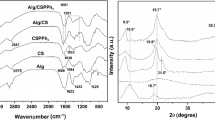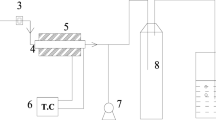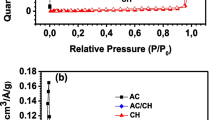Abstract
In this study, chitosan and bio-based activated carbon obtained from sugarcane bagasse biowaste were used for the synthesis of efficient sorbent for Cu(II) and Cd(II) ion via precipitation method. The prepared material was enriched with amino groups through grafting tetraethylenepentamine and tested for heavy metal remediation from water samples. The influence of pH was investigated showing optimum sorption at pH 6 for Cu(II) and Cd(II). Sorption tests, explained by means of the most common sorption models, evidenced that the best performances were reached pointing out the promising application of the prepared sorbent for water purification treatments: Uptake kinetics are relatively fast: the equilibrium was reached within 140 min; and the kinetic profiles were preferentially fitted by the pseudo-second order rate equation. Sorption isotherms are fitted by Langmuir equation. The sorbent showed high metal ion sorption capacity with negligible influence of ion strength. The maximum sorption capacities reached 3.44 and 2.38 mmol g− 1 for Cu(II) and Cd(II), respectively at 298 K. Thermodynamic parameters were evaluated through variation of temperature. The sorption is unfavorable at elevated temperatures. Metal ions were successfully desorbed using 1 M HNO3 solution.








Similar content being viewed by others
References
Shanmugapriya A, Ramya R, Ramasubramaniam S, Sudha PN (2011) Studies on removal of Cr(VI) and Cu(II) ions using chitosan-grafted-polyacrylonitrile. Archiv Appl Sci Res 3(3):424–435
Fraga I, Charters FJ, O’sullivan AD, Cochrane TA (2016) A novel modelling framework to prioritize estimation of non-point source pollution parameters for quantifying pollutant origin and discharge in urban catchments. J Environ Manage 167:75–84
Huang Q, Liu M, Deng F, Wang K, Huang H, Xu D, Zeng G, Zhang X, Wei Y (2016) Mussel inspired preparation of amine-functionalized Kaolin for effective removal of heavy metal ions. Mater Chem Phys 181:116–125
Yan H, Yang L, Yang Z, Yang H, Li A, Cheng R (2012) Preparation of chitosan/poly(acrylic acid) magnetic composite microspheres and applications in the removal of copper(II) ions from aqueous solutions. J Hazard Mater 229–230:371–380
Ahmad R, Hasan I (2016) L-cystein modified bentonite-cellulose nano composite (cellu/cys-bent) for adsorption of Cu(II),Pb(II) and Cd(II) ions from aqueous solution. Sep Sci Tech 51:381–394
Awuala Md R, Hasan Md M (2015) Colorimetric detection and removal of copper (II) ions from wastewater samples using tailor-made composite adsorbent. Sens Actuators B 206:692–700
Awual R (2015) A novel facial composite adsorbent for enhanced copper (II) detectionand removal from wastewater. Chem Eng J 266:368–375
Salah TA, Mohammad AM, Hassan MA, El-Anadoul BE (2014) Development of nano-hydroxyapatite/chitosan composite for cadmium ions removal in wastewater treatment. J Taiwan Inst Chem Eng 45:1571–1577
World Health Organization (2014) Third edition, guidelines for drinking-water quality: recommendations. vol 1, World Health Organization, Geneva
Visa M, Duta A (2013) Methyl-orange and cadmium simultaneous removal using fly ash and photo-Fenton systems. J Hazard Mater 244:773–779
Popuri SR, Frederick R, Chang C, Fang S, Wang C, Lee L (2014) Removal of copper (II) ions from aqueous solutions onto chitosan/carbon nanotubes composite sorbent. Desalin Water Treat 52:691–701
Alsabagh AM, Fathy M, Morsi RE (2015) Preparation and characterization of chitosan/silver nanoparticle/copper nanoparticle/carbon nanotube multifunctional nano-composite for water treatment: heavy metals removal; kinetics, isotherms and competitive studies. RSC Adv 5:55774–55783
Kaur M, Kaur N, Jeet K, Kaur P (2015) MgFe2O4 nanoparticles loaded on activated charcoal for effective removal of Cr (VI)-A Novel approach. Ceram Int 41:13739–13750
Ajmal M, Siddiq M, Aktas N, Sahiner N (2015) Magnetic Co–Fe bimetallic nanoparticle containing modifiable microgels for the removal of heavy metal ions, organic dyes and herbicides from aqueous media. RSC Adv 5:43873–43884
Larous S, Meniai AH, Lehocine MB (2005) Experimental study of the removal of copper from aqueous solutions by adsorption using sawdust. Desalination 185:483–490
Visa M, Chelaru AM (2015) Hydrothermally modified fly ash for heavy metals and dyes removal in advanced wastewater treatment. Appl Surf Sci 303:14–22
Chu K (2002) Removal of copper from aqueous solution by chitosan in prawn shell: adsorption equilibrium and kinetics. J Hazard Mater 90:77–95
Mohan D, Pittman CU, Steele PH (2006) Single, binary and multi-component adsorption of copper and cadmium from aqueous solutions on Kraft lignin bio sorbent. J Colloid Interface Sci 297:489–504
Ngah WW, Hanafiah M (2008) Adsorption of copper on rubber (Heveabrasiliensis) leaf powder: kinetic, equilibrium and thermodynamic studies. Biochem Eng J 39:521–530
Sahiner N (2014) Fast and high amount of uranyl Ion uptake by p (Vinyl Phosphonic Acid) microgels prepared by UV irradiation technique. Water Air Soil Pollut 225:1982–1990
Xie Y, Huang Q, Liu M, Wang K, Wan Q, Deng F, Lu L, Zhang X, Wei Y (2015) Mussel inspired functionalization of carbon nanotubes for heavy metal ion removal. RSC Adv 5:68430–68438
Tofighy MA, Mohammadi T (2015) Copper ions removal from water using functionalized carbon nanotubes–mullite composite as adsorbent. Mater Res Bull 68:54–59
Vakili M, Rafatullah M, Salamatinia B, Abdullah AZ, Ibrahim MH, Tan KB, Gholami Z, Amouzgar P (2014) Application of chitosan and its derivatives as adsorbents for dye removal from water and wastewater: a review. Carbohydr Polym 113:115–130
Vakili M, Rafatullah M, Salamatinia B, Ibrahim MH, Abdullah AZ (2015) Elimination of reactive blue 4 from aqueous solutions using 3-aminopropyl triethoxysilane modified chitosan beads. Carbohydr Polym 132:89–96
Vakili M, Rafatullah M, Ibrahim MH, Abdullah AZ, Salamatinia B, Gholami Z (2016) Chitosan hydrogel beads impregnated with hexadecylamine forimproved reactive blue 4 adsorption. Carbohydr Polym 137:139–146
Elwakeel KZ, El-Sayed GO, Abo El-Nassr SM (2015) Removal of ferrous and manganous from water by activated carbon obtained from sugarcane bagasse. Desalin Water Treat 55:471–483
Jóźwiak T, Filipkowska U, Szymczyk P, Rodziewicz J, Mielcarek A (2017) Effect of ionic and covalent crosslinking agents on properties of chitosan beads and sorption effectiveness of Reactive Black 5 dye. React Funct Polym 114:58–74
Galhoum AA, Hassan KM, Desouky OA, Masoud AM, Akashi T, Sakai Y, Guibal E (2017) Aspartic acid grafting on cellulose and chitosan for enhanced Nd(III) sorption. React Funct Polym 113:13–22
Elwakeel KZ, Elgarahy AM, Al-Bogami AS (2018) Efficient retention of chromate from industrial wastewater by a green magnetic polymer based on shrimp peels. J Polym Environ. https://doi.org/10.1007/s10924-017-1096-0
Bernardi F, Zadinelo IV, Alves HJ, Meurer F, dos Santos LD (2018) Chitins and chitosans for the removal of total ammonia of aquaculture effluents. Aquaculture 483:203–212
Liua B, Chen W, Peng X, Cao Q, Wang Q, Wang D, Meng X, Yu G (2016) Biosorption of lead from aqueous solutions by ion-imprinted tetraethylenepentamine modified chitosan beads. Int J Biol Macromol 86:562–569
Elwakeel KZ (2009) Removal of Reactive Black 5 from aqueous solutions using magnetic chitosan resins. J Hazard Mater 167:383–392
Khakpour R, Tahermansouri H (2018) Synthesis, characterization and study of sorption parameters of multi-walled carbon nanotubes/chitosan nanocomposite for the removal of picric acid from aqueous solutions. Int J Biol Macromol 109:598–610
Atia AA, Donia AM, Elwakeel KZ (2005) Adsorption behavior of non-transition metal ions on a synthetic chelating resin bearing iminoacetate functions. Sep Purif Technol 43:43–48
Tahervand S, Jalali M (2017) Sorption and desorption of potentially toxic metals (Cd, Cu, Ni and Zn) by soil amended with bentonite, calcite and zeolite as a function of pH. J Geochem Explor 181:148–159
Elwakeel KZ, El-Bindary AA, Kouta EY (2017) Retention of copper, cadmium and lead from water by Na-Y-Zeolite confined in methyl methacrylate shell. J Environ Chem Eng 5:3698–3710
Lagergren S (1898) About the theory of so-called adsorption of soluble substances. Kungliga Swenska Vet 24:1–39
Ho YS, McKay G (1999) Pseudo-second order model for sorption processes. Process Biochem 34:451–465
Weber WJ, Morris JC (1963) Kinetics of adsorption on carbon from solutions. J Sanitary Eng Div ASCE 89:31–60
Zeldowitsch J (1934) The catalytic oxidation of carbon monoxide on manganese dioxide. Acta Physicochim URSS 1:364–449
Staron P, Chwastowski J, Banach M (2017) Sorption and desorption studies on silver ions from aqueous solution by coconut fiber. J Clean Prod 149:290–301
Xiao Y, Xue Y, Gao F, Mosa A (2017) Sorption of heavy metal ions onto crayfish shell biochar: effect of pyrolysis temperature, pH and ionic strength. J Taiwan Inst Chem E 80:114–121
Abd El-Ghaffar MA, abdel Wahab ZH, Elwakeel KZ (2009) Extraction and separation studies of silver(I) and copper(II) from their aqueous solution using a chemically modified melamine resins. Hydrometallurgy 96:27–34
Langmuir IJ (1916) The constitution and fundamental properties of solids and liquids. J Am Chem Soc 38:2221–2295
Freundlich HMF (1906) Over the adsorption in solution. J Phys Chem 57:385–470
Dubinin MM, Zaverina ED, Radushkevich LV (1947) Sorption and structure of active carbons. I. Adsorption of organic vapors. Zh Fiz Khim 21:1351–1362
Temkin MI, Pyzhev V (1940) Kinetics of ammonia synthesis on promoted iron catalysts. Acta Physiochim URSS 12:217–222
Xin H, Nai-yun G, Qiao-li Z (2007) Thermodynamics and kinetics of cadmium adsorption onto oxidized granular activated carbon. J Environ Sci 19:1287–1292
Stumm W (1990) Chemistry of the solid-water interface. Wiley lnterscience, New York
Laus R, Costa TG, Szpoganicz B, Fávere VT (2010) Adsorption and desorption of Cu(II), Cd(II) and Pb(II) ions using chitosan crosslinked with epichlorohydrin-triphosphate as the adsorbent. J Hazard Mater 183:233–241
Rahman ML, Sarkar SM, Yusoff MM, Kulkarni AKD, Chowdhury ZZ, Ali ME (2016) Poly(amidoxime) from polymer-grafted Khaya cellulose: an excellent medium for the removal of transition metal cations from aqueous solution. Bioresources 11:6780–6800
Saliba R, Gauthier H, Gauthier R, Petit-Ramel M (2000) Adsorption of copper(II) and chromium(III) ions onto amidoximated cellulose. J Appl Polym Sci 75:1624–1631
Sigdel A, Jung W, Min B, Lee M, Choi U, Timmes T, Kim S-J, Kang C-U, Kumar R, Jeon B-H (2017) Concurrent removal of cadmium and benzene from aqueous solution by powdered activated carbon impregnated alginate beads. Catena 148:101–107
Rao MM, Ramesh A, Rao GPC, Seshaiah K (2006) Removal of copper and cadmium from the aqueous solutions by activated carbon derived from Ceiba pentandra hulls. J Hazard Mater B129:123–129
Karunanayake AG, Todd OA, Crowley M, Ricchetti L, Pittman CU Jr, Anderson R, Mohan D, Mlsn T (2018) Lead and cadmium remediation using magnetized and nonmagnetized biochar from Douglas fir. Chem Eng J 331:480–491
Deng J, Liu Y, Liu S, Zeng G, Tan X, Huang B, Tang X, Wang S, Hua Q, Yan Z (2017) Competitive adsorption of Pb(II), Cd(II) and Cu(II) onto chitosan-pyromellitic dianhydride modified biochar. J Colloid Interface Sci 506:355–364
Song Q, Yang B, Wang H, Xu S, Cao Y (2016) Effective removal of copper (II) and cadmium (II) by adsorbent prepared from chitosan-modified magnetic biochar. J Residuals Sci Tech 13:197–205
Author information
Authors and Affiliations
Corresponding author
Electronic supplementary material
Below is the link to the electronic supplementary material.
Rights and permissions
About this article
Cite this article
Elwakeel, K.Z., Aly, M.H., El-Howety, M.A. et al. Synthesis of Chitosan@activated Carbon Beads with Abundant Amino Groups for Capture of Cu(II) and Cd(II) from Aqueous Solutions. J Polym Environ 26, 3590–3602 (2018). https://doi.org/10.1007/s10924-018-1243-2
Published:
Issue Date:
DOI: https://doi.org/10.1007/s10924-018-1243-2




